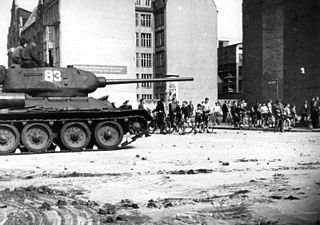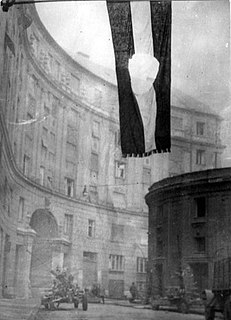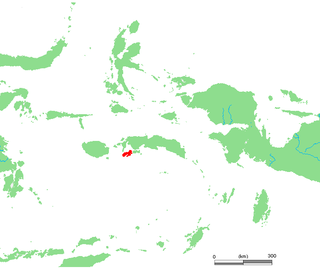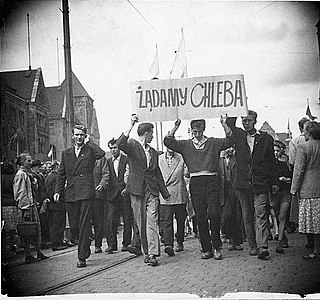 W
WThe 1969 Libyan coup d'état, also known as the al-Fateh Revolution or the 1 September Revolution, was carried out by the Free Officers Movement, a group of military officers led by Colonel Muammar Gaddafi, which led to the overthrow of King Idris I.
 W
WThe 1979 Herat uprising was an insurrection that took place in and around the city of Herat, Afghanistan in March 1979. It included both a popular uprising and a mutiny of Afghan Army troops against the Democratic Republic of Afghanistan (DRA). The communist regime at first appealed to its Soviet allies for help, but the Soviet leadership declined to intervene. After the insurgents seized and held the city for about a week, the regime was able to retake it with its own forces, and the subsequent aerial bombardment and recapture of Herat left up to 25,000 of its inhabitants dead.
 W
WThe Rebellion of Brașov was a revolt against Nicolae Ceaușescu's economic policies in Communist Romania, which erupted on the day of the 1987 local election.
 W
WThe Carnation Revolution, also known as the 25 April, was initially a 25 April 1974 military coup in Lisbon which overthrew the authoritarian Estado Novo regime. The revolution began as a coup organised by the Armed Forces Movement, composed of military officers who opposed the regime, but it was soon coupled with an unanticipated, popular civil resistance campaign. The revolution led to the fall of the Estado Novo, terminated the Portuguese Colonial War, and started a revolutionary process that would result in a democratic Portugal.
 W
WThe Communist insurgency in Malaysia, also known as the Second Malayan Emergency, was an armed conflict which occurred in Malaysia from 1968 to 1989, between the Malayan Communist Party (MCP) and Malaysian federal security forces.
 W
WThe Communist insurgency in Sarawak occurred in Malaysia from 1962 to 1990, and involved the North Kalimantan Communist Party and the Malaysian Government. It was one of the two Communist insurgencies to challenge the former British colony of Malaysia during the Cold War. As with the earlier Malayan Emergency (1948–1960), the Sarawak Communist insurgents were predominantly ethnic Chinese, who opposed to British rule over Sarawak and later opposed the merger of the state into the newly created Federation of Malaysia. The insurgency was triggered by the 1962 Brunei Revolt, which had been instigated by the left-wing Brunei People's Party in opposition to the proposed formation of Malaysia.
 W
WThe Contras were the various U.S.-backed and funded right-wing rebel groups that were active from 1979 to the early 1990s in opposition to the Marxist Sandinista Junta of National Reconstruction Government in Nicaragua. Among the separate contra groups, the Nicaraguan Democratic Force (FDN) emerged as the largest by far. In 1987, virtually all contra organizations were united, at least nominally, into the Nicaraguan Resistance.
 W
WDidžioji Kova military district - is a military district of Lithuanian partisans which operated in 1945 - 1950 in the counties of Vilnius, Kaunas and Ukmergė.
 W
WThe East German uprising of 1953 was an uprising that occurred in East Germany from 16 to 17 June 1953.
 W
WThe Faciliteitenwet, also known as the "Act on the Position of Moluccans", regulates the position of Moluccans living in the Netherlands who do not hold Dutch nationality.
 W
WThe February 28 incident or the February 28 massacre, also known as the 228 incident, was an anti-government uprising in Taiwan that was violently suppressed by the Kuomintang-led Republic of China government, which killed thousands of civilians beginning on February 28, 1947. The number of Taiwanese deaths from the incident and massacre was estimated to be between 5,000 and 28,000. The massacre marked the beginning of the White Terror, in which tens of thousands of other Taiwanese went missing, died or were imprisoned. The incident is one of the most important events in Taiwan's modern history and was a critical impetus for the Taiwan independence movement.
 W
WThe Forest Brothers were Baltic and Estonian partisans who waged guerrilla warfare against Soviet rule during the Soviet invasion and occupation of the three Baltic states during, and after, World War II. Similar anti-Soviet Central and Eastern European resistance groups fought against Soviet and communist rule in Bulgaria, Poland, Romania, and western Ukraine.
 W
WThe Guerrilla war in the Baltic states or the Forest Brothers resistance movement was the armed struggle against Soviet rule that spanned from 1940 to the mid-1950s. After the occupation of the Baltic territories by the Soviets in 1944, an insurgency started. According to some estimates, 10,000 partisans in Estonia, 10,000 partisans in Latvia and 30,000 partisans in Lithuania and many more supporters were involved. This war continued as an organised struggle until 1956 when the superiority of the Soviet military caused the native population to adopt other forms of resistance. The guerrilla movement in the post-war Baltic states was of a size proportionately similar to that of the Viet Cong in South Vietnam.
 W
WThe Hungarian Revolution of 1956, or the Hungarian Uprising, was a nationwide revolution against the Hungarian People's Republic and its Soviet-imposed policies, lasting from 23 October until 10 November 1956. Leaderless at the beginning, it was the first major threat to Soviet control since the Red Army drove Nazi Germany from its territory at the End of World War II in Europe.
 W
WThe Invasion of Ambon was a combined Indonesian military operation which aimed to seize and annex the self proclaimed Republic of South Maluku.
 W
WThe Jeju uprising was an uprising that occurred on Jeju Island in South Korea from April 1948 to May 1949. Residents of Jeju opposed to the Division of Korea had protested and had been on a general strike since 1947 against elections scheduled by the United Nations Temporary Commission on Korea (UNTCOK) to be held only in the territory controlled by the United States Army Military Government in Korea. The Workers' Party of South Korea and its supporters launched an anti-imperialist, communist-linked insurgency in April 1948, attacking the police, and Northwest Youth League members stationed on Jeju mobilized to violently suppress the protests. The First Republic of Korea under President Syngman Rhee escalated the suppression of the uprising from August 1948, declaring martial law in November and beginning an "eradication campaign" against rebel forces in the rural areas of Jeju in March 1949, defeating them within two months. Many rebel veterans and suspected sympathizers were later killed upon the outbreak of the Korean War in June 1950, and the existence of the Jeju uprising was officially censored and repressed in South Korea for several decades.
 W
WThe June 1976 protests were a series of protests and demonstrations in People's Republic of Poland that took place after Prime Minister Piotr Jaroszewicz revealed the plan for a sudden increase in the price of many basic commodities, particularly foodstuffs. Prices in Poland were at that time fixed, and controlled by the government, which was falling into increasing debt.
 W
WThe Khmer People's National Liberation Armed Forces (KPNLAF) was the military component of the Khmer People's National Liberation Front (KPNLF) a political front organized in 1979 in opposition to the Vietnamese-installed People's Republic of Kampuchea (PRK) regime in Cambodia. The KPNLAF was loyal to Son Sann, a former Prime Minister under Prince Norodom Sihanouk and the founder of the KPNLF political movement.
 W
WThe Khmer People's National Liberation Front was a political front organized in 1979 in opposition to the Vietnamese-installed People's Republic of Kampuchea (PRK) regime in Cambodia. The 200,000 Vietnamese troops supporting the PRK, as well as Khmer Rouge defectors, had ousted the brutal Democratic Kampuchea regime of Pol Pot, and were initially welcomed by the majority of Cambodians as liberators. Some Khmer, though, recalled the two countries' historical rivalry and feared that the Vietnamese would attempt to subjugate the country, and began to oppose their military presence. Members of the KPNLF supported this view.
 W
WThe Lithuanian partisans were partisans who waged a guerrilla warfare in Lithuania against the Soviet Union in 1944–1953. Similar anti-Soviet resistance groups, also known as Forest Brothers and cursed soldiers, fought against Soviet rule in Estonia, Latvia, Poland, Romania and Galicia. It is estimated that a total of 30,000 Lithuanian partisans and their supporters were killed.
 W
WLithuanian Partisans Declaration of February 16, 1949 is a document, created by Lithuanian partisans and signed by Union of Lithuanian Freedom Fighters (ULFF) on February 16, 1949 in Minaičiai. By signing the declaration, the ULFF assumed responsibility to lead the restoration of independent democratic state of Lithuania, where equal rights for all citizens and social care is guaranteed. Document also states that "Communist party, as dictatorial and essentially opposite to the main aim of Lithuanian nation and keystone provision of the Constitution – independence of Lithuania, – is not considered a legal party". The declaration appeals to the Universal Declaration of Human Rights, Lithuanian Constitution of 1922 and addresses whole democratic world asking for help.
 W
WPolish October, also known as October 1956, Polish thaw, or Gomułka's thaw, marked a change in the politics of Poland in the second half of 1956. Some social scientists term it the Polish October Revolution, which, while less dramatic than the Hungarian Revolution of 1956, may have had an even deeper impact on the Eastern Bloc and on the Soviet Union's relationship to its satellite states in Central and Eastern Europe.
 W
WThe Polish 1970 Strikes occurred in northern Poland during 14–19 December 1970. The protests were sparked by a sudden increase of prices of food and other everyday items. As a result of the strikes, which were put down by the Polish People's Army and the Citizen's Militia, at least 42 people were killed and more than 1,000 wounded.
 W
WThe Poznań protests of 1956, also known as Poznań June, were the first of several massive protests against the communist government of the Polish People's Republic. Demonstrations by workers demanding better working conditions began on 28 June 1956 at Poznań's Cegielski Factories and were met with violent repression.
 W
WThe Revolutions of 1989 formed part of a revolutionary wave in the late 1980s and early 1990s that resulted in the end of communist rule in Central and Eastern Europe and beyond. The period is often also called the Fall of Communism and sometimes called the Fall of Nations or the Autumn of Nations, a play on the term Spring of Nations that is sometimes used to describe the Revolutions of 1848.
 W
WThe Afghanistan conflict is a series of wars that has been fought in Afghanistan since 1978. Starting with the Saur Revolution military coup, an almost continuous series of armed conflicts has dominated and afflicted Afghanistan. The wars include:The Soviet–Afghan War began in 1979 and ended in 1989. The Soviet Army invaded the country to secure the ruling People's Democratic Party of Afghanistan (PDPA) following large waves of rebellion against the regime. Soviet troops along with the allied Afghan Army fought against rebel factions mostly known collectively as the "Afghan mujahideen", whose main backers were the Soviet Union's Cold War enemies the United States, United Kingdom, and Pakistan. The Soviet Union was forced to withdraw its troops in 1989. The Afghan Civil War (1989–1992) was the continuing war between the government and rebels, but without the involvement of Soviet troops. The Soviet Union nevertheless continued to financially support the Afghan government in its fight, and likewise rebel factions continued receiving support from the United States and Pakistan. The Soviet-backed Afghan government survived until the fall of Kabul in 1992. The Afghan Civil War (1992–1996) began when infighting between the mujahideen rebel factions, after taking Kabul and establishing the Islamic State of Afghanistan, escalated into another full blown conflict. Violent wars were fought between different occupying factions in Kabul, and the city experienced heavy bombardment from them. Each of these were supported by an outside power, such as Pakistan, Iran, or Saudi Arabia, who were seeking influence in Afghanistan. This conflict ended in 1996 after the Taliban, a relatively new militia backed by Pakistan and enforced by several thousand al-Qaeda fighters from Arab countries, took Kabul. The Afghan Civil War (1996–2001) started immediately after the Taliban's capture of Kabul which involved a new military-political resistance force called Northern Alliance fighting against the Taliban and their partially recognized Emirate. Throughout this period the Taliban were in control of almost all of the country, as the Northern Alliance fought most of the time on the defense. The Alliance's leader was assassinated by al-Qaeda members on September 9, 2001. The United States invasion of Afghanistan started on October 7, 2001. The United States sought to remove the Taliban from power as they were hosting al-Qaeda terrorists and camps, who were the main suspects of the September 11 attacks. The United States fought the Taliban from the air and provided support to Northern Alliance ground troops, who successfully drove the Taliban away from most of the country by December 2001. The invasion also marked the start of the United States's War on Terror. The War in Afghanistan (2001–present) is the continuous incumbent war in Afghanistan, where the main conflict consists of Afghan Army troops, backed by additional United States troops, fighting against insurgents of the Taliban and sporadically other groups as well. NATO has also been involved in this war.